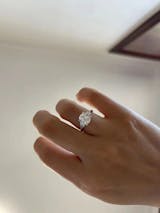18K WHITE GOLD VS. PLATINUM: PICK YOUR RING’S BFF!
Share

So, you’re shopping for an engagement ring or a blingy new accessory, and suddenly you’re drowning in metal options. 18K white gold? Platinum? It’s like choosing between avocado toast and a cronut—both amazing, but wildly different vibes. Let’s skip the textbook jargon and break this down over a metaphorical latte.
Understanding the Basics: What Are 18K White Gold and Platinum?
Before diving into comparisons, let’s clarify what these metals actually are:
18K White Gold(Au 750)
Composition: A blend of 75% pure gold and 25% alloy metals (e.g., nickel, zinc, or palladium).
Color: Naturally has a faint yellowish tint due to its gold content. To achieve a bright white finish, it’s coated with a thin layer of rhodium, a platinum-family metal.
Durability: Extremely hard and scratch-resistant (Mohs hardness ~4–5), making it ideal for intricate designs.
Platinum (PT950/PT900)
Composition: 95% or 90% pure platinum mixed with alloys like palladium or ruthenium.
Color: Naturally white and does not require plating. Over time, it develops a soft patina but remains white.
Durability: Softer than white gold (Mohs hardness ~3–4) but denser and heavier.

Key Differences Between 18K White Gold and Platinum
Appearance and Color Longevity
18K White Gold:
Starts with a brilliant white shine thanks to its rhodium plating.
Over time (2–3 years, depending on wear), the rhodium layer wears off, revealing a slightly warm undertone.
Requires periodic re-plating (re-rhodiuming) to maintain its bright white appearance.
Platinum:
Naturally white throughout, with no plating needed.
Scratches or wear will not change its color—it simply develops a matte “patina” that many find charming.
Perfect for those who want a “set it and forget it” metal that stays white forever.
Winner: Platinum for color stability; white gold for initial brilliance (with maintenance).
Durability and Maintenance

18K White Gold:
Pros:
Highly resistant to bending or warping, making it ideal for prong settings that hold diamonds securely.
Perfect for intricate designs (e.g., pave settings, filigree, or halo styles) due to its rigidity.
Cons:
Rhodium plating wears off, requiring maintenance every 2–3 years.
Alloy metals like nickel may cause skin irritation for sensitive wearers.
Platinum:
Pros:
Hypoallergenic and naturally pure, ideal for sensitive skin.
Dense and heavy, offering a luxurious, substantial feel.
Cons:
Softer metal means scratches and dents are more noticeable over time.
Prongs may loosen faster than with white gold, increasing the risk of losing smaller accent stones.
Winner: 18K white gold for durability in active lifestyles; platinum for hypoallergenic comfort.
Weight and Comfort
Platinum’s Density:
Platinum is about 60% denser than gold. A platinum ring will weigh significantly more than a similarly sized white gold ring.
Example: A 3-gram 18K white gold band would weigh approximately 4.5 grams in platinum.
Some love the “heft” of platinum, while others find it less comfortable for daily wear.
White Gold’s Lightness:
Lighter weight makes it easier to wear for long periods, especially with larger designs.
Winner: Subjective—choose based on your preference for a substantial or lightweight feel.
Design Versatility

18K White Gold:
The go-to choice for elaborate designs:
Holds small diamonds securely in pave or channel settings.
Allows delicate details like milgrain, engraving, or latticework.
Also available in rose gold (copper alloy) or yellow gold variants for mixed-metal styles.
Platinum:
Best for classic, minimalist designs:
Smooth solitaire bands, bezel settings, or three-stone rings.
Avoid intricate pave work—softer prongs may loosen tiny stones.
Winner: 18K white gold for creativity; platinum for timeless elegance.
Who Should Choose 18K White Gold?
You’re a fan of bold, detailed designs: Think halo settings, vintage-inspired filigree, or stacked rings.
You lead an active lifestyle: Its scratch resistance suits hands-on jobs or frequent wear.
You don’t mind occasional upkeep: Budget for rhodium replating every few years.
Who Should Choose Platinum?
You prioritize purity and symbolism: Platinum’s rarity mirrors the uniqueness of your commitment.
You have sensitive skin: Its hypoallergenic properties reduce irritation risks.
You want zero maintenance: No replating needed—just polish scratches if desired.
Other Options to Consider
14K or 10K White Gold: Lower gold content (58.5% or 41.7%) increases hardness and reduces cost but may appear less vibrant.
Customization: Want 18K prongs on an platinum band? Sure.We can Frankenstein that for you.

Final Tips for Choosing Your Ring Metal
Try Both: go to the store wear sample bands to feel the difference in weight and comfort.
Here’s no universal “best” metal—it depends on your priorities. If you crave intricate designs and don’t mind upkeep, 18K white gold offers unmatched versatility. If you value hypoallergenic purity and a maintenance-free experience, platinum’s timeless appeal is unbeatable.
Pro Tip: Discuss your daily habits and design vision with your jeweler. A great ring isn’t just beautiful—it’s built to last a lifetime.
Ready to create your dream ring? Explore our customizable options in both 18K white gold and platinum, tailored to your story. 💍



